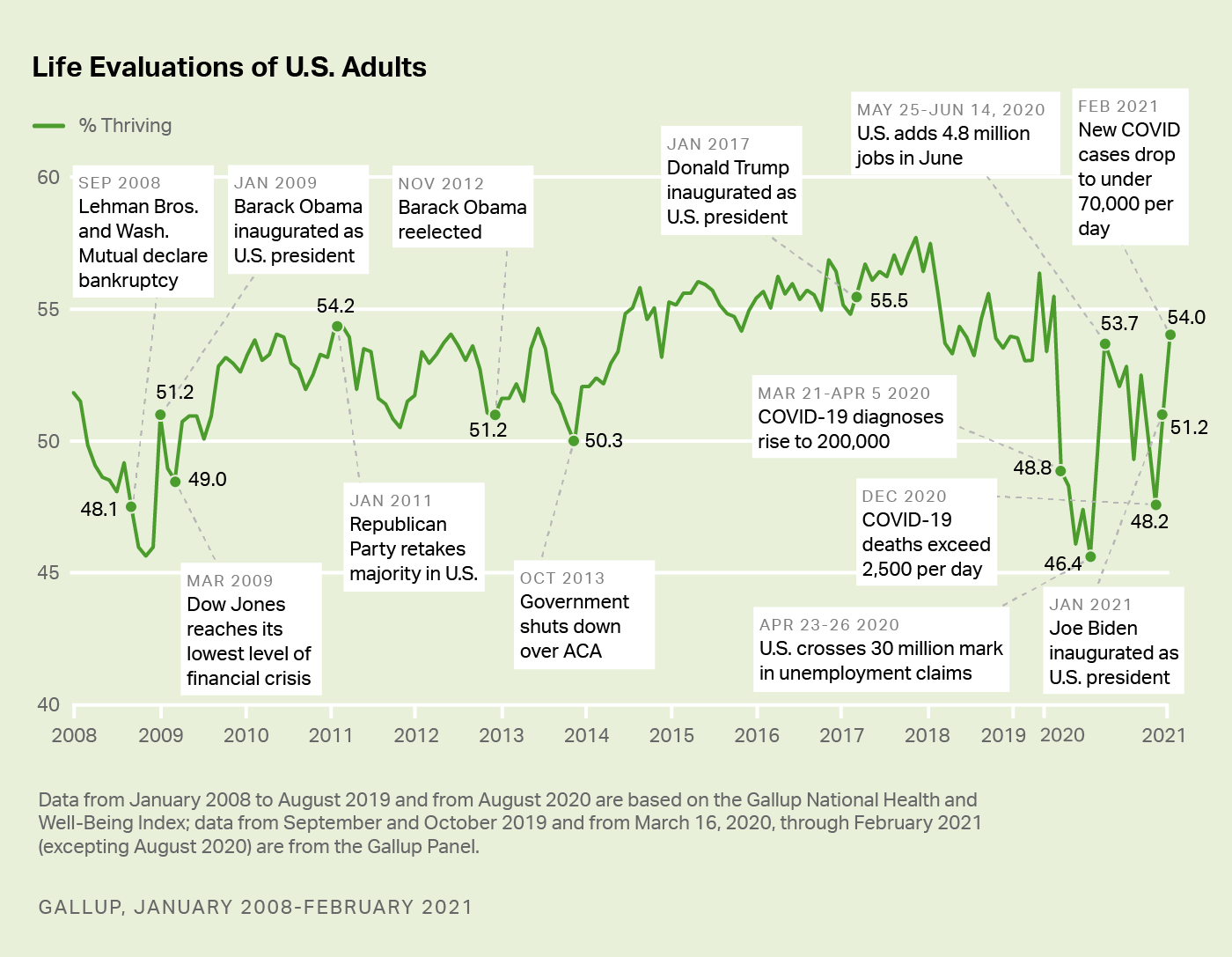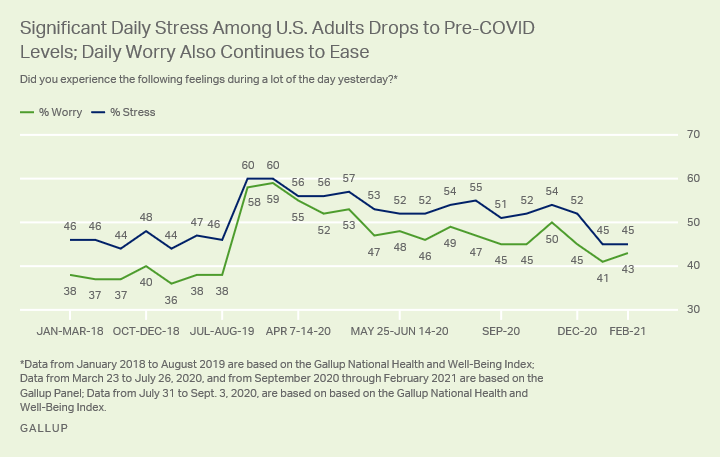Story Highlights
- Current life satisfaction bounces back to near pre-COVID-19 levels
- Significant daily stress matches pre-COVID-19 rate for first time
- Significant daily worry also continues to ease
WASHINGTON, D.C. -- The percentage of Americans who evaluate their lives well enough to be considered "thriving" rose to 54.0% in February, now nearly recouping the entirety of the losses since October 2019. Amid the sharply worsening pandemic, the thriving percentage had slipped to 48.2% in December, its lowest point since late April.

The most recent results, captured Feb. 15-21, 2021, are based on web surveys completed with 3,735 U.S. adults as a part of the Gallup Panel, a scientifically populated, non-opt-in panel of about 120,000 adults across all 50 states and the District of Columbia.
Gallup classifies Americans as "thriving," "struggling" or "suffering" according to how they rate their current and future lives on a ladder scale with steps numbered from 0 to 10, based on the Cantril Self-Anchoring Striving Scale. Those who rate their current life a 7 or higher and their anticipated life in five years an 8 or higher are classified as thriving.
Over the course of 2008, during the Great Recession, 48.9% of U.S. adults were classified as thriving. The lowest individual monthly ratings that year came in the fourth quarter, including 46.7% in October, 46.4% in November and 46.7% in December. These remained the three lowest levels assessed by Gallup over the entire 13+ years of measurement until the final week of April 2020, when the 46.4% mark was again reached. The percentage of Americans estimated to be "suffering" has remained steadily low throughout the pandemic and in line with pre-COVID-19 estimates. In February 2021, 3.2% of respondents were classified as suffering.
Satisfaction With Current Life Rebounds in February
Americans' current life satisfaction was the major driver of the initial decline in the thriving percentage in 2020. By late April, the percentage of American adults who rated their current lives a "7" or higher had plunged about 11 percentage points, even as the anticipated life satisfaction five years forward had improved. And as with the decline in the thriving percentage, its subsequent improvement has been heavily influenced by the rebound in current life satisfaction, up over six points since late April.
Notably, however, even as current life satisfaction has risen in recent months, anticipated life satisfaction remains elevated in comparison with pre-COVID levels. These results are possibly a reflection of the suppressed current life ratings but nevertheless potentially signal an opportunity for the thriving percentage to continue to improve in the coming months.
| Current life satisfaction | Anticipated life satisfaction | ||||||||||||||||||||||||||||||||||||||||||||||||||||||||||||||||||||||||||||||||||||||||||||||||||
|---|---|---|---|---|---|---|---|---|---|---|---|---|---|---|---|---|---|---|---|---|---|---|---|---|---|---|---|---|---|---|---|---|---|---|---|---|---|---|---|---|---|---|---|---|---|---|---|---|---|---|---|---|---|---|---|---|---|---|---|---|---|---|---|---|---|---|---|---|---|---|---|---|---|---|---|---|---|---|---|---|---|---|---|---|---|---|---|---|---|---|---|---|---|---|---|---|---|---|---|
| % 7-10 | % 8-10 | ||||||||||||||||||||||||||||||||||||||||||||||||||||||||||||||||||||||||||||||||||||||||||||||||||
| Sep 30-Oct 14, 2019 | 67.7 | 65.5 | |||||||||||||||||||||||||||||||||||||||||||||||||||||||||||||||||||||||||||||||||||||||||||||||||
| Mar 21-Apr 5, 2020 | 58.2 | 68.0 | |||||||||||||||||||||||||||||||||||||||||||||||||||||||||||||||||||||||||||||||||||||||||||||||||
| Apr 23-27, 2020 | 56.9 | 68.9 | |||||||||||||||||||||||||||||||||||||||||||||||||||||||||||||||||||||||||||||||||||||||||||||||||
| Dec 14, 2020-Jan 3, 2021 | 58.0 | 66.7 | |||||||||||||||||||||||||||||||||||||||||||||||||||||||||||||||||||||||||||||||||||||||||||||||||
| Jan 25-31, 2021 | 62.1 | 65.8 | |||||||||||||||||||||||||||||||||||||||||||||||||||||||||||||||||||||||||||||||||||||||||||||||||
| Feb 15-21, 2021 | 63.3 | 69.2 | |||||||||||||||||||||||||||||||||||||||||||||||||||||||||||||||||||||||||||||||||||||||||||||||||
| Gallup Panel | |||||||||||||||||||||||||||||||||||||||||||||||||||||||||||||||||||||||||||||||||||||||||||||||||||
COVID-19-Era Spikes in Daily Stress and Worry Continue to Recover
In addition to the general life ratings, Gallup also tracks whether Americans have significantly experienced specific emotions, including stress and worry, in their daily lives.
The percentage of people who reported experiencing stress and worry "a lot of the day yesterday" showed unprecedented increases in the first half of March 2020, with stress rising 14 points to 60% and worry rising 20 points to 58%. Reports of experiencing these emotions have subsequently diminished. Daily stress -- which had ticked back up to 54% of the population in November, has since plummeted to 45% and now (as it did in January) matches prepandemic rates for the first time since the initial spike. Daily worry, in turn, was reported by 43% of respondents in February, which is now nearly back to 2019 levels.

Line graph. The percentages of Americans reporting that they felt worry or stress a lot of the day yesterday. In February of this year, 45% of Americans said they felt stress a lot of yesterday, while 43% said they felt a lot of worry.
Implications
As the U.S. crosses the one-year mark of its first confirmed death attributable to COVID-19, the wellbeing of its residents is closing out a tumultuous 12-month stretch. By April, the rise of the pandemic and subsequent economic shutdown resulted in a drop in the percentage of thriving Americans to a 12-year low -- a decrease that was even steeper than the one measured more than a decade ago (nearly 10 points last year, compared with about six points in 2008). Marked improvements currently underway in the thriving percentage and in current life satisfaction likely reflect the steady decline in new cases, hospitalizations and deaths over the past several weeks.
The extraordinary spikes in stress and worry far exceeded the increases gauged during the Great Recession. Those modest increases in 2008 took about two years to fully ease as the economy slowly improved. In contrast, the current recovery of stress and worry to pre-pandemic levels appears to be on track to occur in about half of that time. The killing of George Floyd, in turn, which catalyzed nationwide protests during the early months of the pandemic in May and June, also preceded a sharp increase in anger and sadness, underscoring how differing life events can trigger changes in distinct emotional experiences.
The end of 2020 was also characterized by the U.S. presidential election in which Joe Biden defeated Donald Trump. It is possible that the uptick in stress and worry in November was partially influenced by the disagreements of some over the outcome, in addition to the worsening pandemic situation. The improvement in the key wellbeing metrics thus far in 2021 could, therefore, also partially reflect the practical resolution of the political disputes and Biden's inauguration, as the percentage of adults categorized as thriving also increased early in the first terms under Barack Obama and Trump.
Learn more about how the Gallup National Health and Well-Being Index works.
Learn more about how the Gallup Panel works.




